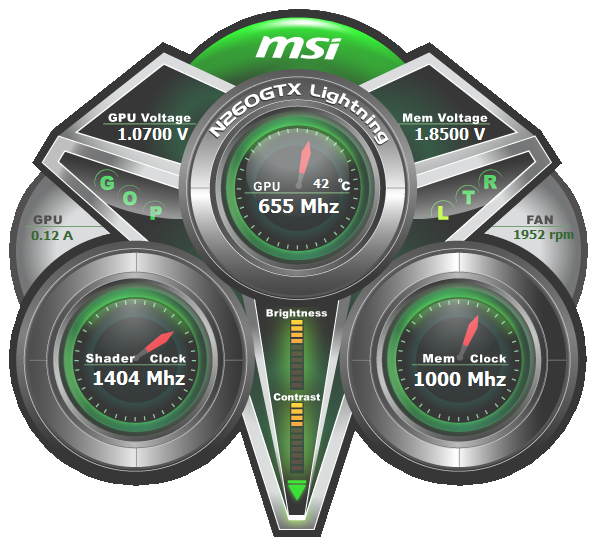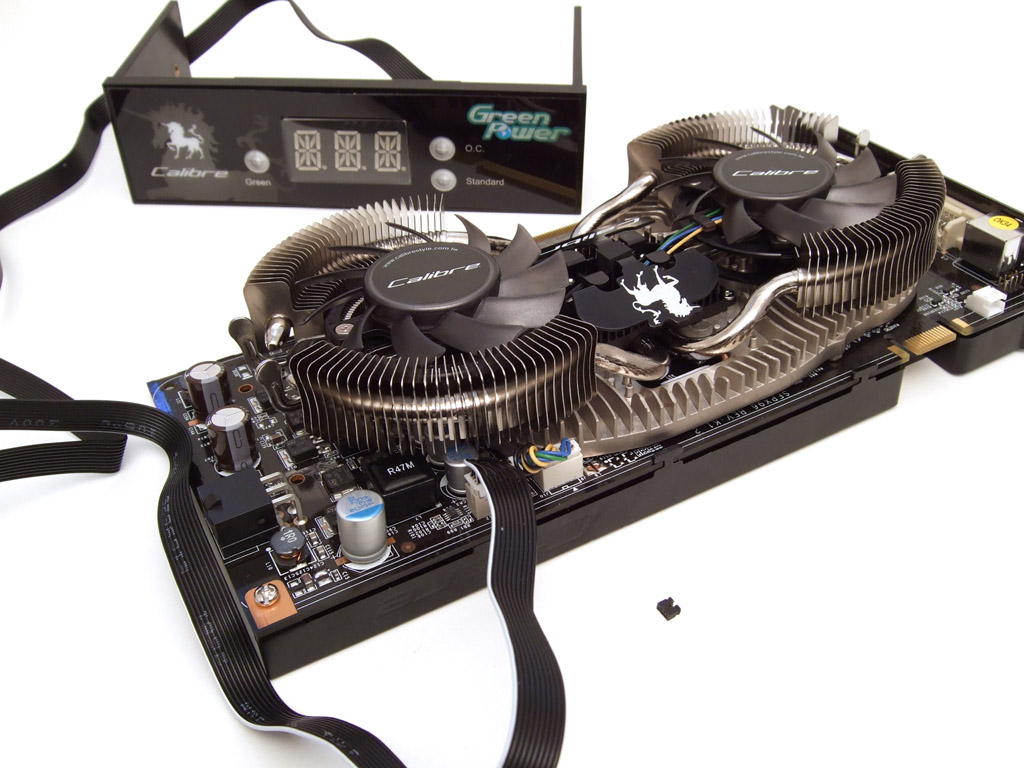Graphics Overclocking: Getting The Most From Your GPU
Overclocking: Nvidia With CoreCenter And AirForce
All told, there are three different ways to overclock the MSI GeForce GTX 260 Lightning. Option one is using the D.O.T. feature integrated in the driver, which we have already covered. Option two consists of MSI’s CoreCenter, which is available as a separate download. This tool offers several usage profiles such as Game, Office, Silence, or Cool and lets you monitor (though not adjust) the fan speed.
Option three takes the guise of the AirForce panel and the Lightning software included with the card. In our test, the combination of CoreCenter and Lightning software produced some errors. For example, the CoreCenter profiles were not applied correctly, with the 2D values remaining in effect even when the card switched to 3D mode. Since using two different utilities is redundant anyway, we reinstalled our system and opted to use the Lightning software exclusively. CoreCenter remains a good choice for cards that don’t come with more extravagant features like the AirForce panel and its Lightning software. Other companies offer similar tools, such as Smart Doctor (Asus) or Precision (EVGA).
The AirForce panel is purely a luxury. It draws its power from an internal or external USB port. As soon as the Lightning software is installed, you have everything you need to control your card literally at your fingertips. The panel’s surface is touch-sensitive, and changes are immediately transmitted to the graphics card. Several colored LEDs let you monitor settings, with more LEDs coming on at higher settings. Whenever it detects a change, the Lightning software appears on your screen, giving you a detailed readout of the card’s exact frequencies, temperature, and fan speed, as well as the voltages for the memory and GPU.
There are three basic profiles to choose from: Game, Office, and Power Saving, and each can be set to its own GPU, shader, and memory frequency. Your settings are saved for each profile, but if things do go bad, you can also reset the card to its default settings (default being the card's factory overclocked frequencies, of course).
This also corresponds to the software’s “Game” profile, by the way. Thus, any overclocking you attempt is on top of those elevated factory settings, and you can increase frequencies for the GPU, shaders, and memory separately. We hit a maximum of 680/1,458/1,050 (GPU/shaders/memory), which doesn’t look like too much of an improvement over the card’s stock speed of 655/1,404/1,000 MHz until you take into account that a normal GeForce GTX 260 is clocked at 576/1,242/999 MHz.
The Power Saving configuration also bears mentioning, since it can reduce power consumption from 137 to 122 Watts.
| 2D Mode AirForce Panel | Clock Speeds (GPU/Shaders/Memory) | Watts (2D) | Temperature (2D) | dB(A) 2D |
|---|---|---|---|---|
| Game | 655/1,404/1,000 | 137 | 43 | 36.5 |
| Office | 350/700/600 | 132 | 42 | 36.5 |
| Power Saving | 300/600/100 | 122 | 40 | 36.5 |
| Game Maximum | 680/1,458/1,050 | 137 | 43 | 36.5 |
| Office Maximum | 550/1,100/900 | 135 | 43 | 36.5 |
In order to stabilize the card at higher clock speeds, you can additionally increase the voltage for the memory and the GPU using the AirForce panel. We had to crank the voltage up to the second-to-last setting to get our sample stable at our final overclock. Since you can only choose from predefined settings, that would seem to imply that the hardware should survive at these levels. The fan speed profile also takes the additional overclocking into account, and the fan spins up quite audibly to tackle the additional heat output. Thus, heat shouldn’t be a problem, and we are happy to report that even the memory modules are cooled as well.
Get Tom's Hardware's best news and in-depth reviews, straight to your inbox.
| Game Mode | Minimum | Stable | Maximum |
|---|---|---|---|
| GPU Voltage | 1.0700 Volts | 1.1200 Volts | 1.1325 Volts |
| Memory Voltage | 1.8500 Volts | 1.8800 Volts | 1.9000 Volts |
Sparkle offers a similar product in its GeForce 9600 GT Calibre, which also comes with a panel. It connects to the card using a ribbon cable, allowing turning the panel into a control interface. In Sparkle’s case, however, the selection is limited to predefined profiles such as Green (energy saving), Standard (default clock speeds), and OC.
A major advantage of this approach is that, since the profiles are saved directly in the panel and the graphics card and are transmitted directly to the card via cable, you are completely independent of the driver. Thus, you’ll never need to worry about the O/C feature breaking in a future driver release.
Current page: Overclocking: Nvidia With CoreCenter And AirForce
Prev Page Benchmarks: Nvidia And D.O.T. Next Page Benchmarks: Nvidia And GeForce 186.18-
dingumf What the hell, I thought this was a guide to overclocking the GPU as the title reads "Graphics Overclocking: Getting The Most From Your GPU"Reply
Then at the end Tom's Hardware screws me over and writes "Conclusion: It’s A Tie"
Isn't this a tutorial? -
they tell you how to overclock using CCC or riva tuner, or evga precision, they also tell you, overclocking = more performance at the cost of more power. what else do you want?Reply
-
dingumf joeman42What is really needed is a "continuous" OC utility that can detect artifacts during actual use and adjust accordingly. I've noticed that my max OC tends to change each time I test and depending on the tool I test with (e.g., atitool, gputool, rivatuner, and my favorite, atitraytool). Some games, l4d in particular, crash at the slightest error. Others such as COD and Deadspace are somewhat tolerant. Games like Far Cry 2 and Fear 2 don't seem to care at all. It would be nice if the utility could take this into account.As for the tools themselves, Atitraytool has far and away the best fan speed adjuster, the dual ladder Temp/Speed is a model of simplicity. Plus, it can automatically sense a game and auto OC just for the duration. Nothing like this exists on the NV side (you must explicitly specify each exe). Unfortunately, I am on a NVidia card now and Rivatuner is pretty much the only game in town for serious tweaking. IT IS A DESIGN DISASTER! random design with no discernable structure. A help file which consist solely of the author bragging about his creation, without explanation as to where each feature is implemented or how to use it. And no, scattered tooltips is not an acceptable alternative. It took forever to figure out that I needed to create a fan profile and then a macro and then create a rules to fire the macro which contains the fan profile just to set one(!) fan speed/temp point (and repeat as needed). Sorry for the rant, but I really hate Rivatuner!Reply
Oh hello. That's what OCCT is for. -
nitrium Rivatuner works just fine with the latest drivers (incl. 190.38). Just check the Power User tab and under System set Force Driver Version to 19038 (or in the articles case 18618) - no decimal point. Be sure that the hexidecimal display at the bottom is unchecked. All Rivatuner's usual features can now be accessed.Reply -
masterjaw I don't think this is intended to be an in-depth tutorial like dingumf perceives. It's just for people to realize that they could still get more from their GPUs using tools.Reply
On the other hand, I don't like the sound of "It's a tie". It looks like it is said just to show neutrality. ATI or Nvidia? It doesn't matter, as long as your satisfied with it. -
quantumrand I must say, the HD 2900 is a great card. I picked up the 2900 Pro for $250 back in 2007 and flashed the bios to a modified XT bios with slightly higher clocks (850/1000). The memory is only GDDR3, but with the 512bit interface, it really does rival the bandwidth of the 4870. I can get it to run Crysis at Very High, 1440x900 with moderately playable framerates (about 25fps, but the motion blur makes it seem quite smooth). Really quite amazing for any 2007 card, let alone one for $250.Reply -
quantumrand Just a bit of extra info on the 2900 Pro...Reply
The Pros were bassically binned XTs once ATI realized that the card was too difficult to manufacture cheaply (something about the high layer count it takes to make a 512bit PCB), so in order to sell their excess cores, the clocked them lower and branded them as Pros. Additionally, they changed the heatsink specs as well, adding an extra heatpipe. Because of this, the Pros could often OC higher than the XTs, making them essentially the best deal on the market (assuming you got a decent core). -
Ramar Overclocking a GPU generally isn't worth it IMO, but sometimes can give that extra push into +60fps average. Or to make yourself feel better about a purchase like myself; one week after I bought a 9800GTX they came out with the GTX+. A little tweaking in EVGA Precision brought an impressive 10% overclock up to GTX+ levels and left me satisfied.Reply -
manitoublack I run 2 Palit GTX295's and have had great success with palit's "Vtune" over clocking software. I believe it works with cards from other vendors as well. Easy to use and driver independent.Reply
Cheers for the great article
Jordan -
KT_WASP ReplyConclusion: It’s A Tie
I didn't know they were in competition until I read that.....I too thought this was about overclocking a GPU in general, not which card you should buy. Once again Toms throws that little barb at the end to stoke the fires.
I think they do this constantly to get more website hits.. If the can get a good ol' fanboy war on every article, they will get people coming back over and over again to add fuel to the fire. After all, the more hits they get, the more they get paid from their sponsors. Which BTW, seam to be taking up more real estate then actual content on this site these days.



